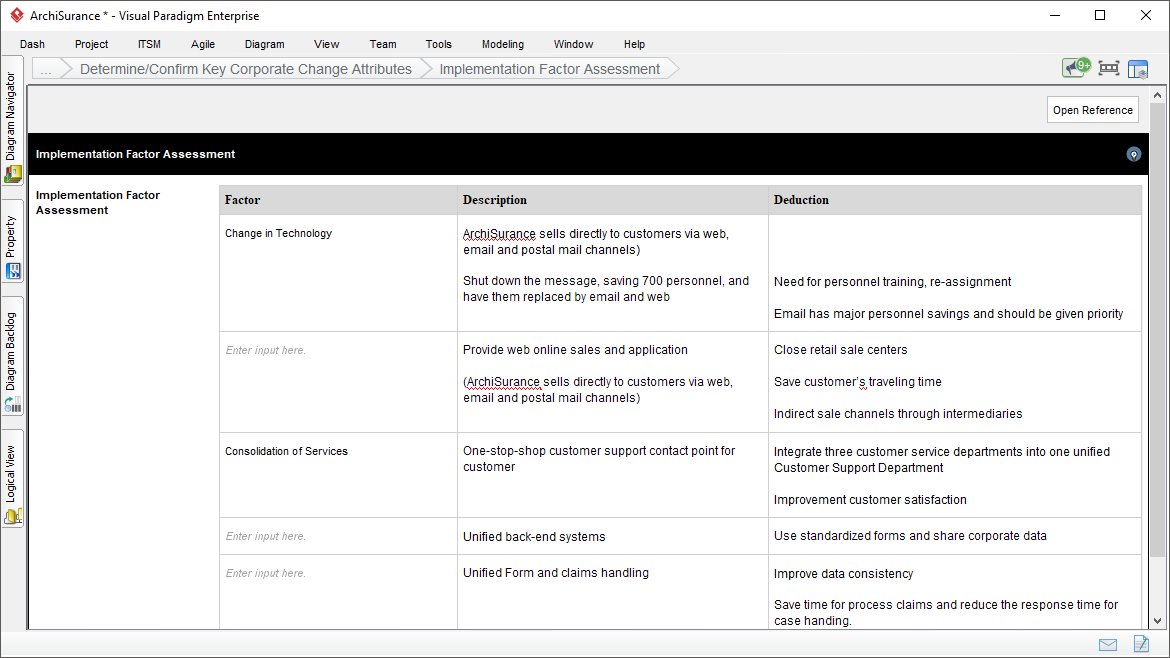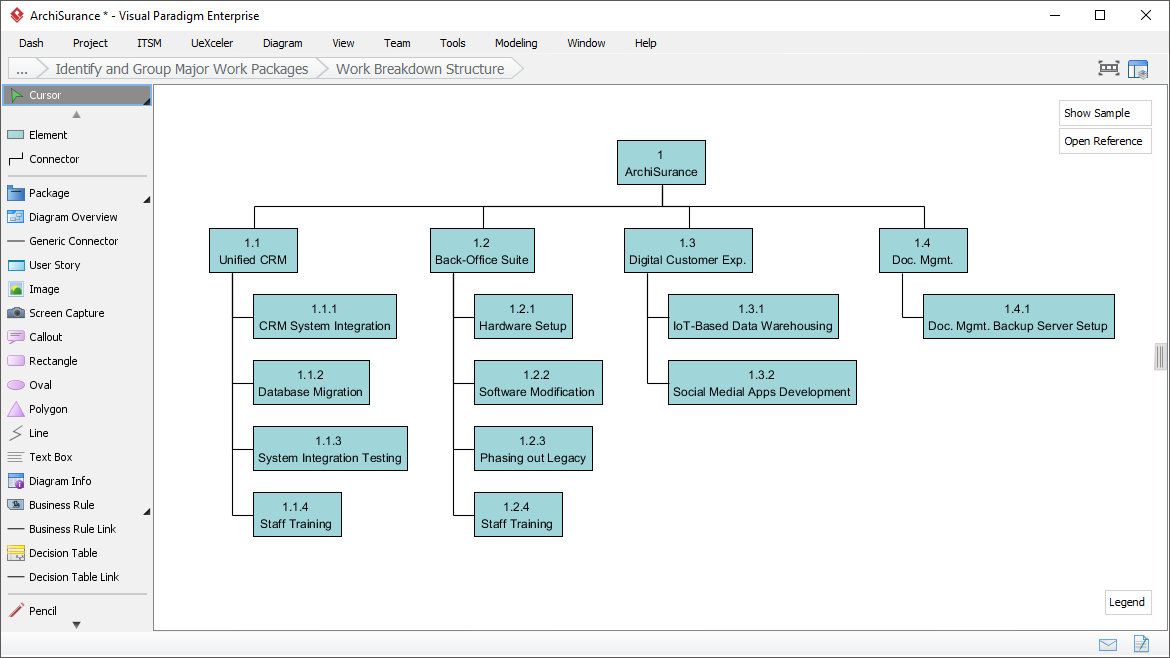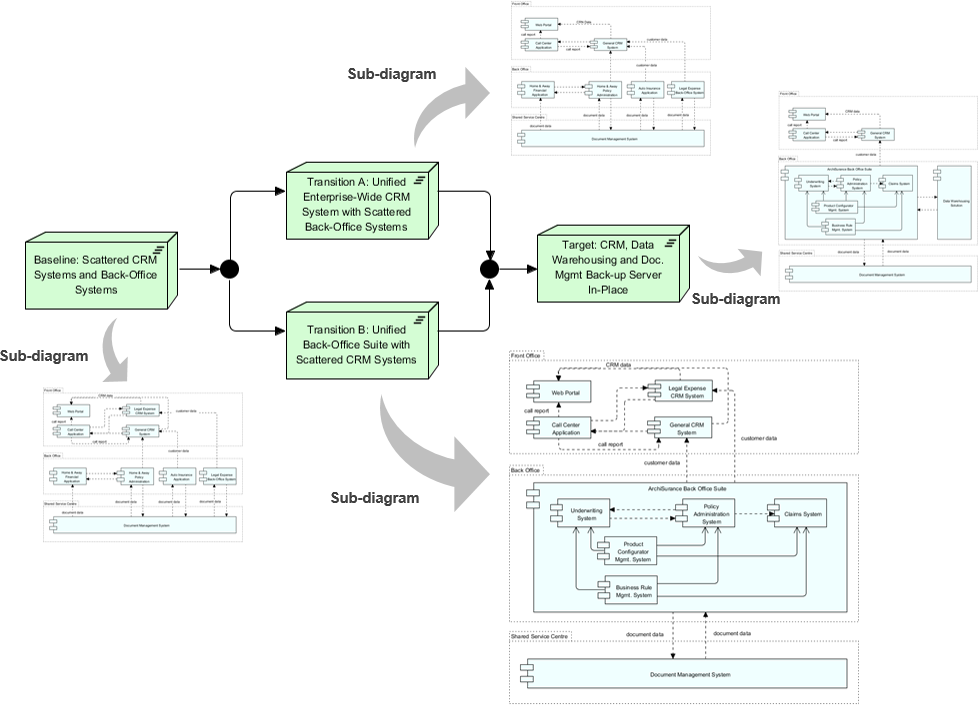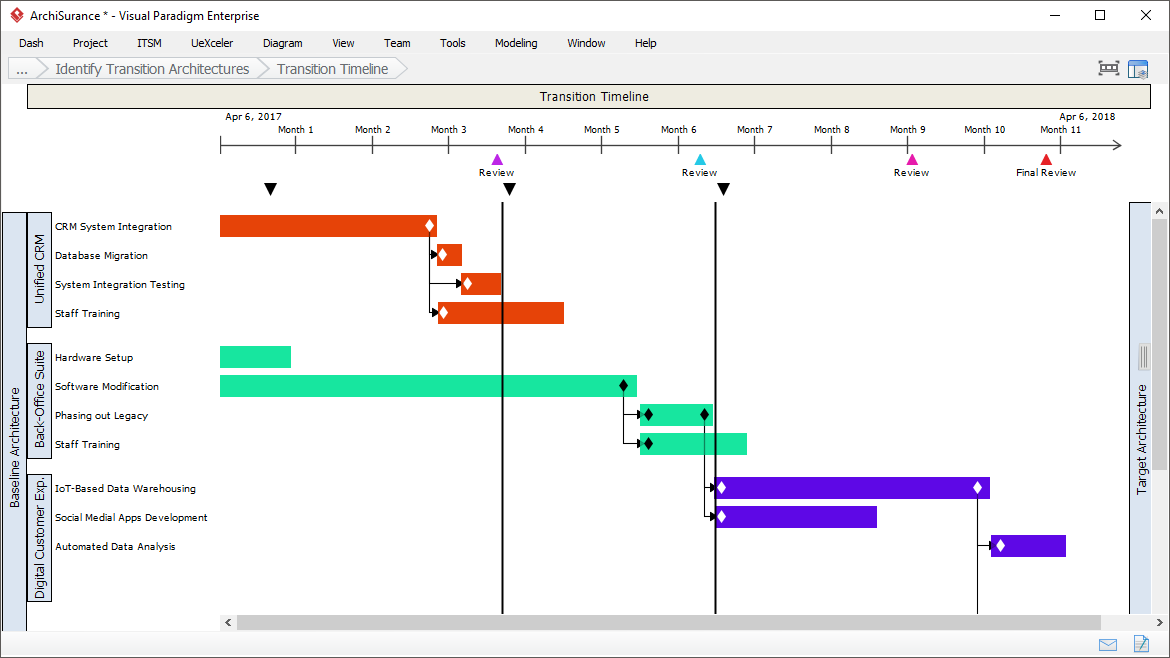Architecture Roadmap is one of the TOGAF deliverables you can create with the TOGAF software.
The Architecture Roadmap lists individual increments of change and lays them out on a timeline to show progression from the Baseline Architecture to the Target Architecture. The Architecture Roadmap forms a key component of Transition Architectures and is incrementally developed throughout Phases B, C, D, E, and F within the ADM.
The purpose of this document is to define one or more architecture roadmaps for the relevant domain/sub-domain.
Note: The roadmap may also need to be synchronized with wider program/project plans or more strategic roadmaps.
Note 2: The role of the current planning functions will determine the level of detail and breadth of information on the architecture roadmaps.
Note 3: Care should be taken to minimize the duplication of effort and content in order to produce plans/roadmaps.
Step 1: Confirm Implementation Factors and Consolidated Gaps
Review the Implementation Factor Assessment matrix and make necessary updates
Review and confirm the Implementation Factor Assessment performed in phase E.
In Phase B, C and D you have developed the target Business, Data, Application and Technology Architectures. In phase E, an Implementation Factor Assessment has been performed to find out the actions or constraints that have to be taken into consideration when formulating the implementation plans of the target architectures.

Review the consolidated gaps and make necessary updates
Review the consolidated gaps and solutions to ensure it correctly reflect stakeholders’ expectation.
Step 2: Confirm Work Breakdown Structure
Review the Work Breakdown Structure and make necessary updates
Review the Work Breakdown Structure and the definition of work packages.
The Work Breakdown Structure (WBS) is a hierarchical description of the work that must be done to complete the deliverables. Each descending level in the WBS represents an increasingly detailed description of the project deliverables.

Review the WBS Dictionary
The Work Breakdown Structure Dictionary (WBS Dictionary) lists all the WBS elements involved in a project. Each WBS element has a definition which can be thought of as a mini scope statement.
In this step, you are required to enter the definition of each of the WBS element created in the Work Breakdown Structure.
Review the definition of work packages
Detail the work packages, which are project activities extracted from the lowest level of branches in Work Breakdown Structure. In this step, you are required to complete the work package portfolio by entering the followings details for each work package:
- Definition: Description of work.
- Deliverable(s): The result of completing the work package. It can be a part of a project deliverable (e.g. a feature), or in form like a document or report.
- Cost: The expenditure of this work package.
- Resource Needs: Resources need to complete this work package.
- Milestones: Major events in the work package, such as the planned start and completion of work, date of review or any important meetings.
Step 3: Confirm Transition Architectures Definition
Review the definition of Transition Architectures and make necessary updates
Review the definition of Transition Architectures and gaps to ensure it correctly reflect stakeholders’ expectation.

Review the architecture outcome for each architecture state and make necessary updates
You have confirmed the roadmap that shows the migration from Baseline to Target Architecture. In this step you are required to review and confirm the Architecture outcome for each of the Baseline, Target and Transition Architectures.

Review the Transition Timeline and make necessary updates
Review the Transition Timeline. Modify it if it was not approved by stakeholders.
The transition timeline presents the scheduling of work packages, which in turns presents a timeline of the progression from the Baseline Architecture to the Target Architecture. The following are some actions you can do to modify the timeline:
- Configure the timeline in the roadmap by providing a start date and specifying the project. Configuration can be made by right clicking on the timeline and selecting Configure… from the popup menu.
- Drag on the edge of the work package bars to adjust their start and end dates.
- Position the vertical Transition Architecture bar(s) based on their planned delivery dates.
- [Optional] Indicate any major milestones below the timeline. To do this, right click on the timeline and select Add Check Point Here from the popup menu, and then give it a meaningful caption (e.g. Interim Review).
- [Optional] Indicate the date when investment/funding will be made. To do this, right click below the check points region and select Add Investment Point Here from the popup menu, and then give it a meaningful caption (e.g. Initial Funding).
- Review and touch-up the captions as desirable (e.g. To give a meaningful name to the diagram)

Step 4: Determine the Dependencies among Work Packages
Visualize the dependencies among work packages in PERT chart
With the use of a PERT chart, identify dependencies between work packages, assign resources for each task, look at overall dates, and identify start and end dates for the tasks.
A set of tasks are generated based on the work packages defined in the Work Breakdown Structure. In this activity, you are required to:
- Connect the work packages to reflect their dependencies.
- Adjust the start and end date for each work package.
- Enter a responsible person for each work package. (Optional)
